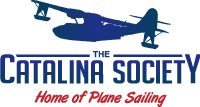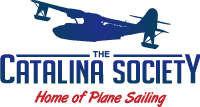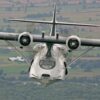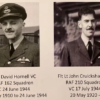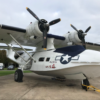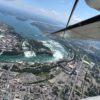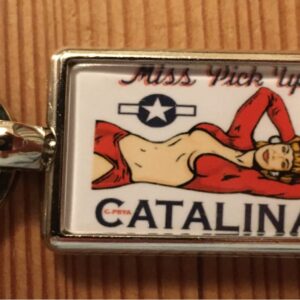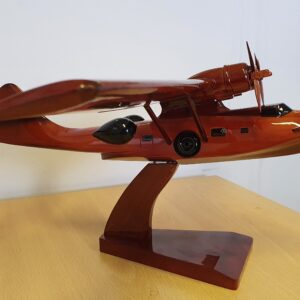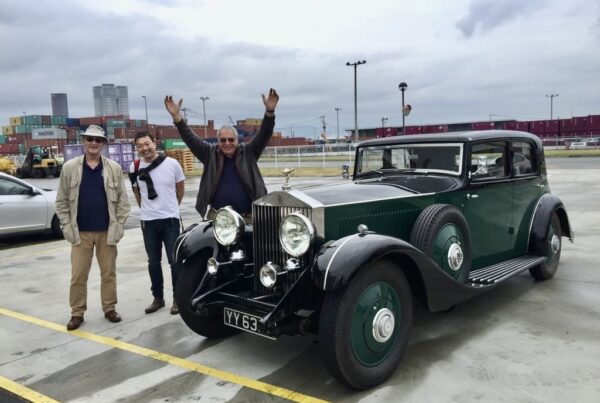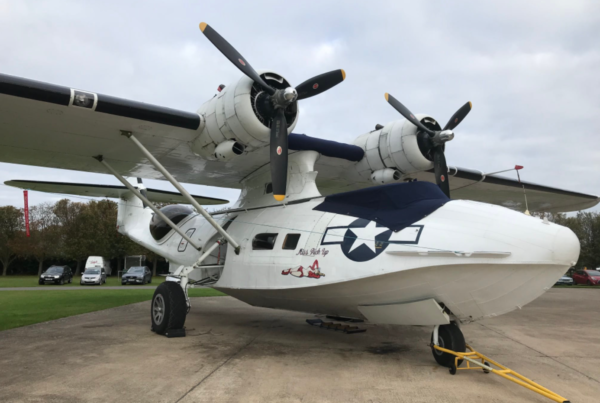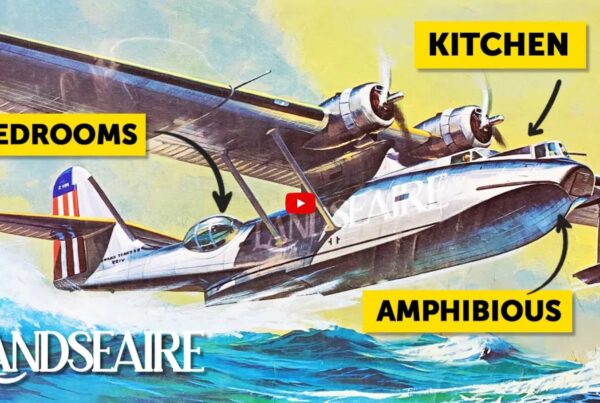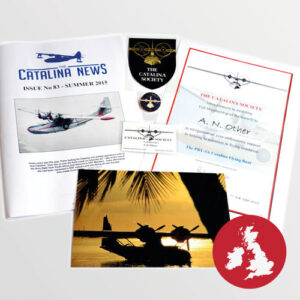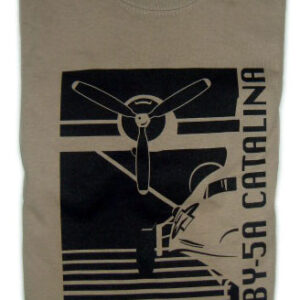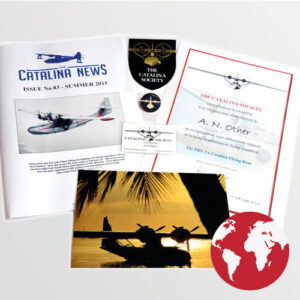“The Catalina In Her Element”
Marina di Venezia, Rimini, Riccione, Viareggio, Forte dei Marmi….. the place names sound like an extract from an up-market Italian holiday brochure. But the next two months promise to be no holiday. During July and August, we have no less than fifty landings to make, just off the beach at all the major Italian tourist resorts. The plan is to use the Catalina as a promotional vehicle for Peroni, arriving each morning as if by magic, showing off the ever-impressive lines of the aircraft (and the corporate logo) before touching down a few hundred yards off the beach, taxiing up to a mooring buoy and having our young Italian hostesses hand out free samples of Peroni’s Nastro Azzurro beer from the rear fuselage blisters!
Guido Bonfiglio is the mastermind behind this particular project. With considerable experience of offshore power boat racing behind him, he has recently become the proud owner of the most impeccable Catalina in Europe, possibly the world – PBY-5A N9521C – which boasts a two-tone US Navy colour scheme and an impressive 12-seat interior. But with limited engineering facilities and limited ability to support a long-term operation, he has decided to call on the services of Europe’s most experienced Catalina operators, Plane Sailing, and the well-known Duxford-based Catalina VP-BPS – recently returned from an exhilarating 6-week tour of South America for Peter Stuyvesant.
So it is that we have discussed the details at length. What are the limits for wind and waves? (15 kt and 2 ft) How will the landing areas be cleared of other traffic? (Coastguard patrols and safety boats) Who will survey the beaches for rocks? (Ground support party) How many crew are needed for a 2-month operation? (Minimum 3, but with rest periods and crew changes) Can we fly every day for 60 days? (Not unless we double the crew!) Can the Catalina communicate with the Coastguard boats on marine frequencies? (Yes – she’s equipped with VHF marine band, as well as VHF air band and HF radios) In Italian? (No!) What sort of mooring will we need? (Double anchor prepositioned, with floating buoy and trailing buoy and line for easy pickup) And how will we get permission to land, when seaplanes have not been seen for decades? (Use Italian negotiating techniques!) But with a project like this it is almost inevitable that problems will be encountered down route – and we’ll look at some of those later. Suffice to say, it is a tribute to all involved that over two summers of operation – 4 months in total – and 100 visits to beach sites, the Catalina never missed a single day’s flying for technical reasons, and whilst on the water suffered no more than a broken glideslope aerial (the nose-mounted location certainly not being an original feature of the Catalina!), a dented nose where a `helpful’ inflatable driver forgot how to slow down or steer, and a small cut in the rear fuselage skin where an errant safety boat strayed too close in choppy seas.
Today, the surface looks quite incredible. From a height of 500-1000 ft, the hazy morning sun glints and sparkles like the reflections from a chandelier. But why? As we complete our flypasts along the beach to show off the Peroni logos, we see the surface more clearly. It is like undulating glass. There is not a breath of wind, and the surface movement is the leftover result of yesterday’s winds and swell. The prospect of an undulating, glassy surface for a runway brings just a hint of adrenalin to the heartbeat – we will be unable to judge our height above touchdown, so will be relying on power setting, vertical speed indicator, airspeed indicator and attitude to achieve a safe landing – but we must also be certain that the ripples are just that, and not something bigger and potentially dangerous. We have good communication with the safety boat, who assure us the ripples are only 30-40 centimetres high ….. can we rely on their judgement? They are on the water right at the landing point, so they should be accurate, but we’ll treat their assessment with healthy suspicion nonetheless. So for this one we set the Catalina up exactly in the groove. We have an accurate pressure setting, having taken off just a few minutes earlier and only a few miles away at Pisa airport. This means we can safely take the Catalina down to 200 feet on the altimeter, run past the landing point and safety boat for about a mile and a half (keeping them in sight – no easy task as we sweat in the hot haze!) then turn in for the approach, final checks complete, reducing speed to 72 knots, settling the rate of descent at 100-150 feet per minute, adjusting power around the 17″ datum, above all holding the attitude correct, in about 20 seconds or so we should be smack!….. wrong again, the visual illusion of a glassy landing proves its power again, as if we would ever doubt it. And this lumpy, glassy surface sucks onto the hull like a limpet, giving us a smooth, rapid roller coaster ride the likes of which I have never felt before.
What a contrast with a few days ago! Then, we had perfect conditions, a light breeze of 5 knots or so, just a three-inch ripple on the morning sea to break the surface and give perspective, good visibility and an easy approach. Is there such a thing as an easy landing? Some might say so, but I never would. There are just some landings which are more difficult than others, some which decide to test your skill and experience, some which acquiesce in the knowledge that they could frighten you at a moment’s notice if they chose to do so, so why bother? As the saying goes, aviation is not inherently dangerous, but it is terribly unforgiving of any carelessness; and when you combine aviation with the open sea, you have an environment which must be treated with the utmost respect – without which you should not be here in the first place. But all is well, we touch down a few yards from the safety boat, glide off the step without a drop of water breaking on to the cockpit, gracefully taxi up to the buoy, cutting first one engine, using the slight crosswind and swing to finesse the approach, pick up the line at the first attempt, cutting the second engine just right ….. it all looks so easy when it goes well ….. if only they knew just how much training and attention and preparation and experience went into a successful arrival. It is as though the sea and the Catalina are living creatures. They can be whipped into submission, and they will obey for the time being, but sooner or later they will bite back, and hard. Or they can be loved and respected, coaxed into doing something which they really both enjoy, if only they would admit it! – but on a bad day being allowed to have their say, tell us that they just want to be left alone today, please come back tomorrow. And being living creatures ourselves, we shall only succeed if we are in tune and show them both the respect they deserve.
We did just that at Otranto. They were both a bit grumpy. The Catalina had a fouled spark plug earlier in the day. The sea was being difficult. Was there a swell running, or was that just a slightly larger chop than we would prefer to see, nonetheless OK for the Catalina? A careful low approach and I reckon it is just about good enough. Wartime Catalina pilots would have taken it in their stride I’m sure, but they could always get another aircraft if they got the landing wrong, assuming they were still alive. And if someone was in the water awaiting rescue, things are seen in a rather different light. This one’s going to be wet, though.
In fact, the hardest part of a rougher landing is looking after the Catalina after the touchdown. Manoeuvring in a 15 knot crosswind is not so easy, when your engines are near the centreline. We have drogues of course, but Garry will get wet and soon very cold as he operates at the nose of the aircraft, from where our drogues have to be deployed. The Catalina will be pitching a lot, and the cockpit will be completely covered in water from time to time. We’ll get wet inside as well, because it’s impossible to keep the water out completely. So even before we touch down our post-landing plan must be finalised – how to get the checks done, how to approach the buoy, and most importantly how to get airborne again quickly if conditions deteriorate.
The second hardest part is the landing itself. In a rough sea, the Catalina can cut cleanly through the first three water impacts, after which the speed will be low enough to make the arrival tolerable no matter how she meets the water thereafter ….. or she can ricochet off a wave crest, leaping skyward like a flying fish – and, if this happens at around 45 knots, we are too slow to put on power and fly away, and too fast for comfort; the next impact will be a boneshaker. Above all, we must HOLD THE ATTITUDE, for it is only in the planing attitude that she stands a chance of cutting through the sea the way she is meant to. It is a very physical job! We shall feel the stickiness of anticipation as we approach, then the sudden transition from thoroughbred, flying machine to fragile, thin-skinned boat, then the rough demand for control inputs as we steer in the wind and the waves. We’ll land `along the swell’ of course, though really we don’t like to accept more than a foot of swell, so much more powerful is its effect on the poor Catalina than even a three-foot chop of short wavelength. But as any competent mathematician will tell you, landing `along the swell’ requires a curving track if the swell is not to be crossed as speed reduces after touchdown – not the easiest of manoeuvres. And of course, real seas do not have nice, regular swells, but rather they have a general direction of swell with irregularities just where you happen to be alighting! So we don’t like swell! Today, the swell is a foot with a foot of chop on top and a wind of just over 10 knots. But the landing is good, with the hull cutting cleanly through the succession of waves just as the designers must have intended (albeit 60 years ago!), there is a hum of achievement buzzing through the Cat as we slow to taxiing speed, whether from the old girl herself or from the crew, disciplined with silence on the intercom, I know not ….. though I suspect the former. We moor up with ease, despite the conditions, because for the moment all the living creatures involved are on our side, content to allow a difficult job to be done with skill, even though they didn’t really want it until we pointed out that they should let us today.
There is a temptation to relax now; is it a hint of fear that doesn’t let me do so, or is it the mixture of smiling and seasick crew on the safety boat that conveys a subliminal warning? Perhaps it is the darkening sky. Perhaps we sense a slight shift in the wind. Smiles turn to shouts – very Italian! – but suddenly, so suddenly, there is a need to get out of here. It was the thunder we missed just below the noise of the wind and waves; the lightning is clearer now though, and it’s coming our way. The wind veers, I call for action: safety boat clear, blisters shut, crew to stations. The pre-start checks were completed already (with settings for takeoff already made), just after the shutdown checks; all we need is to strap in, put the battery master on, confirm we are singled up ready to slip, and engage the starter ….. (is a prayer for a clean start in order, I wonder?) ….. within 3 minutes of the first flash of lightning we are under way again, clear of the buoy, hatches shut, completing takeoff checks. We need just a very few minutes to get the cylinder head temperatures up, and we’ll spend this time in our favourite water manoeuvre, the orbit! Once our Catalina is going round in an orbit, she is happy to sustain it even in a 15 knot wind, and it has the great advantages of going nowhere – with judicious use of power each time we come into wind – thereby helping others on the water to avoid us and minimising the need to look out for unexpected obstacles, boats, fishing buoys etc – and of making a smoother patch on the water, through which we can make our initial acceleration into wind on takeoff.
Surprisingly, the easiest part of a rough water operation – for us at least – is the takeoff. Our Cat has so much power with her Wright Cyclone engines that even the roughest of seas which we can take for landing will give us no more than a couple of gentle bumps as we accelerate rapidly into the more favourable element. It is a job that demands all my feeble muscle power nonetheless! We would like to take off into wind, as would anyone sensible. But into wind is across the swell, and there is absolutely no difficulty in deciding which is the lesser of two evils: a crosswind takeoff along the swell beats an into-wind takeoff across the swell any day. But my tame mathematician reminds me that an along-swell take off requires a curving path. I wish he would shut up sometimes, even though he’s right. I have full aileron applied into wind, stick hard back with help from co-pilot Keith Sissons (and from our engineer, Garry Short, who has a rope to pull the control column back!) to get the nose out of the water, differential power as we open up to counteract the swing into wind, waves breaking over the cockpit, an eye on the propellers to make sure we don’t bring the power up too much until we start to slide up the step clear of the water; we track a lovely curve, though whether it was luck, judgement, or a guiding hand from above I am never quite sure! The sea has lost us, and rough as it is it doesn’t even bother to give us a kick as we return to the skies where, for now, we feel more at home and safer. Floats up, power back, mixtures lean, heading for dry land and the airfield, radio call, landing checks (oh so careful to put the gear down, not the floats this time), a smooth arrival, a cup of tea in the hotel. A day to look back on, to learn from always, but to feel satisfied with as well. We used our experience, the aircraft behaved beautifully in limiting conditions, we got the job done as safely as is possible, the team pulled together, and for now we can rest happily!
Every evening, as we look back over the day’s experiences over a glass of Italian beer – though seldom the Nastro Azzurro we spend the day promoting – we try to draw out one lesson to be remembered for the future. The days of operating large flying boats on the open sea are gone now, probably forever. But as we plan to operate our Catalina to her fullest for many years to come, we want to retain our hard-earned knowledge and give our crews the best chance to complete future missions with the minimum of fuss, the maximum of safety and the fewest lost heartbeats!
Today, the lesson is about mooring. From a spectator’s point of view – and we have plenty of those most days, with some of them much too close for comfort at times – the mooring is either a non-event (ie we moor up at the first attempt), or else a hilarious 10 minutes of stopping, starting, shouting and very Italian gesticulating!
The technique varies with the wind. (Fortunately, we don’t really have any current to cope with, which adds another dimension again to the technique needed on a fast-flowing river.) We invariably want to make our final approach to the buoy into the wind. This helps to reduce our speed through the water and, most importantly, gives the rudder a good deal of authority to refine our direction in the late stages. But it’s not that easy being sure of the wind direction once you’re on the water and splashing through the waves so the first essential is to make sure the wind direction has been set on the compass heading bug before touchdown – we normally want to land into wind anyway. (The swell direction is set up for reference on the compass course bar as well.)
Provided the approach to the buoy is clear for a couple of hundred yards into wind we shall then position for a longish approach directly toward the buoy, using the last couple of hundred yards to reduce speed with both engines at idle power, and carefully positioning the aircraft exactly into the wind with the buoy just a foot or so off the port bow, ready for the crew member in the nose hatch to pick up with his boat hook. By carefully `blipping’ the magneto master switch we can reduce the engine speed from normal idle around 700 rpm down to about half that, again helping to get the speed low. Finally, with the buoy about 20-50 yards ahead, we cut the engines and drift on to the buoy. The problem is that if we miss the buoy – perhaps by being just a couple of feet too far away to the right, or perhaps through bad luck at the moment of pickup – our forward speed of 5-8 knots will very quickly reduce to zero and then to a surprisingly high rearward speed. The Catalina has a lot of surface for the wind to blow on! There is one last chance to catch the buoy as we drift back past it but we must use the rudder to point the nose of the aircraft to the right if we want to drift left, and vice versa, and the big problem is that the buoy will be blown by the wind to the full extent of its line and must be attached to the Cat immediately on pickup, or it will be pulled out of our hands. And if we miss the buoy on the rearward drift we shall have to start up very rapidly for another go.
The fun really starts when there is only a short approach to the buoy available into wind. A downwind approach is really out of the question, as speed will be far too high and accurate directional control almost impossible. Downwind, the Catalina will travel in a straight line, but only if pointing exactly downwind. The moment she is just a few degrees away from true downwind, a swing will build up very rapidly, so direction must be held with eyes like a hawk, picking as point ahead and holding it there with differential power, and perhaps aileron/rudder as well.
A crosswind approach is usually out of the question as well. The only time when we would consider this is when there is a long steady approach in the crosswind direction and some other restriction that makes an into-wind approach more difficult. In this situation, provided the crosswind is reasonably strong, we can shut down the downwind engine and taxi crosswind quite happily on the upwind engine. At idle, the wind will turn us like a weathercock towards the wind; but with a little power applied the engine will turn us the other way. By judicious use of engine power, direction can be pretty well controlled. But if we miss the buoy at the first pass then the escape plan will have to be ready, because the situation is bound to be untidy. At best, we shall need to restart the other engine to reposition for another run. One advantage of this type of approach, however, is that the speed through the water will be much reduced, making the whole procedure easier – typically we shall do about 4-5 knots on one engine, rather than 8-9 knots on two engines.
By combining the techniques from the into-wind and crosswind approaches, we can produce the approach that we find the most successful of all. On the face of it, it looks difficult; and, until you have practised it a few times, it is – but then, most mooring work in the Catalina is quite demanding! It goes like this (we hope!).
The approach starts with a downwind leg. Direction must be carefully controlled, as described before, because of the tendency to weathercock into wind. On the downwind track, the Catalina passes about 75 yards to the side of the buoy, and continues downwind another 100 yards. Now, a touch of rudder will start a swing to whichever side the buoy is on. At the same moment, the outside engine is cut – leaving a delightfully controllable situation where the wind is swinging the aircraft around towards the buoy, and the application of just a touch of power on the remaining engine allows the turn to be held off to achieve the radius of turn needed to position correctly on to the buoy. The added advantage is that, with only one engine running, speed will progressively reduce, making the task of picking up the line that bit easier. As the buoy approaches, the second engine is cut and – if all is well – a graceful arrival and safe mooring is achieved. When in practice, we find these approaches are successful about 90% of the time. Of course, there are always points of finesse, and these vary with almost every approach. For example, we must remember that when the second engine is cut, there will be a gentle swing towards that engine. So should we perhaps aim to complete the approach just slightly out of wind the other way, or should we use extra rudder to give more rudder authority after shutdown, or should we just keep the buoy directly on the nose until the second shutdown? If you try it one day, do let me know!
Previous Comments:
Keith Hill – 5 December, 2006
Are you returning to Italy in 2007? I am interested in joining you for a day. I work on minor aviation development in Arctic areas for the Scott Polar Institute Cambridge. Also speak fluent Italian if that is useful (25 years there)
